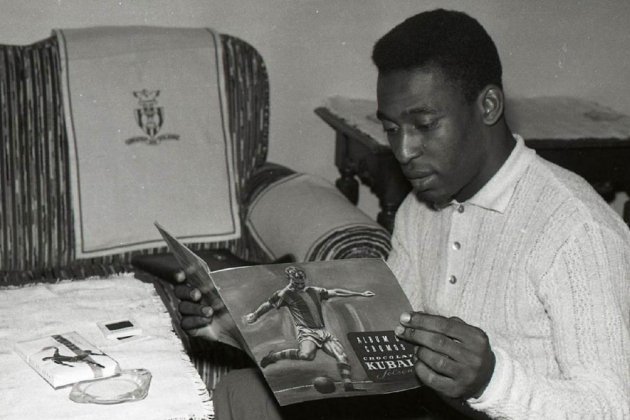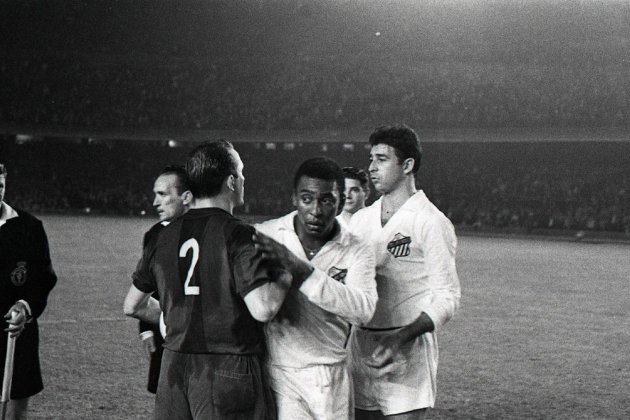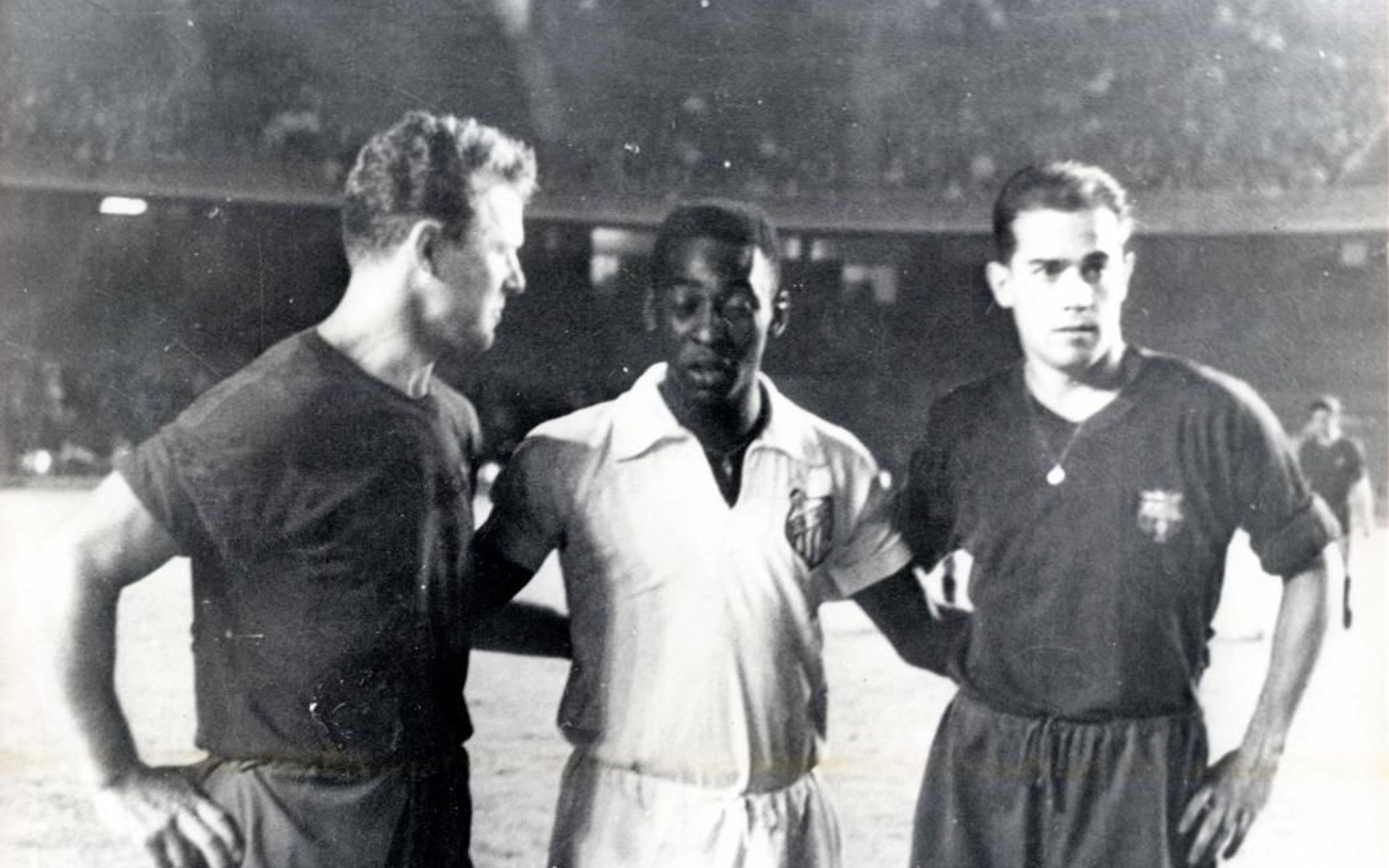Is there any better stage in the world than the Camp Nou to let the footballing magic of the Brazilians shine like a sun? Long before Romario, Ronaldo, Rivaldo, Ronaldinho or Neymar lived the best years of their lives playing for FC Barcelona, the first Brazilian star, and the greatest of all time, lost 4-3 against Barça on the second of three occasions when he played at the blaugrana club's colosseum, in a match full of so many peculiarities that it could have been the base for a dimestore novel.
A match that was hanging by a thread
On the night of July 2nd, 1960, Kubala, Pelé and Luis Suárez took an iconic photo just minutes before the start of a friendly that almost never got played. Weeks before it was announced that the Santos FC of Pelé, Zito and Zé Carlos would be the star guests at the Copa Ciudad de Barcelona, a four-team summer tournament in which Italy's Padova and the other Barcelona city team, Espanyol, would also participate; the quadrangular format paired Barça against the Italians in a semi-final so that Espanyol faced the Brazilian team and, in this way, the two hometown teams could both have a crack against Pelé. On June 28th, in the first semi-final, two goals from Vergés and one from Barça's Hungarian legend Kubala allowed the blaugranes to seal a 3-1 victory and secure a place in the final. But then off-field events intervened and the next day's semi-final between Espanyol and Santos never happened.
The Brazilian Football Confederation, claiming that it needed players from Santos to compete in the Copa del Atlántico against the national sides of Argentina, Paraguay and Uruguay, sent a request to the Spanish Federation - and from there, passed on to Catalan football bosses - for the tournament to be cancelled and the Brazilian players to return to Brazil, arguing that they needed to rest after more than twelve friendlies played in just over forty days. Espanyol, who had cancelled a friendly in Rome and a tournament in Algeria in order to play Santos, learned just hours before the match that they would not face Pelé's team. In the midst of the general cacophony and in order to minimize the breach-of-contract sum they would have to cough up after signing up for two exhibition matches in Barcelona, Athié Jorge Coury, president of Santos, mediated with the Brazilian Football Confederation, which finally accepted that the São Paulo team would arrive in Brazil on July 4th, but with one condition: Santos could play one game, but not two.

Revenge for the year before
Indeed, when, after too many trans-Atlantic phone calls and headaches, Barça and Santos took to the pitch on July 2nd, little could the two teams and the tournament organizers have imagined that they still had one more hurdle to overcome: the heavens opened, the typical summer torrential rainstorm that is pleasant to appreciate from the porch at home but very uncomfortable for a spectator sitting in Camp Nou's vast arena of uncovered seating, opened barely three years before. The deluge that fell on the pitch from the thirtieth minute of the game was so great that, in fact, the 40,000 fans were informed via the PA system that those attending had permission to sit wherever they wanted, which meant that they all piled into those seats that were protected from the elements by the upper tiers. It was exactly two years earlier that a very young Pelé, aged just eighteen, had amazed the world by winning the World Cup in Sweden with the canarinha, the first in Brazil's history. A year later, taking advantage of the fame that the magical teenager had given Santos, the Brazilian club had already made its first European tour in which it had visited Barcelona, offering a football recital and winning 1-5 against the Barça trained by Helenio Herrera.
A year later, however, things would have a different colour. Sitting on the blaugrana bench was Ljubiša Broćić, the Yugoslavian coach who had taken over from Herrera who, despite winning two leagues in a row, had been sacked at the end of the 59-60 season. Barça were not the same team as the previous summer, nor did Pelé shine as he had a year before, possibly thanks to some ferocious marking by Olivella. With the fatigue that comes from a tour of almost a month and a half, travelling halfway around the world from friendly to friendly, the Brazilian team succumbed to a devastating first half in which the blaugrana managed to place a surprising 4-0 on the scoreboard, with two goals from the "Architect" Suárez, one from Kubala and another from Villaverde. The excess relaxation of the Barça team and the pride of the Brazilians, however, combined to allow a different game to be played in the second half: two goals from Pepe in just twenty minutes and a third goal, the work of Pelé, cut distances until the 4-3 final, a result to which the many decisive saves by Antoni Ramallets, who may have haunted Pelé's dreams that night, contributed.

The final absurd touches of a memorable night
That match, after being on the threshold of suspension, ended up being played at 10:45pm, a late start although by no means the only time that Camp Nou has hosted games that went into the small hours - a case in point being the blaugrana debut of another Brazilian legend, Ronaldinho, more than forty years later, with kickoff at 00:05 in the morning. Like Ronnie on that famous 2003 night, Pelé had played in the 1960 match with his favourite number, 10, just like Suárez - also 10 - and Kubala, with the number 9 he always wore, but what the Santos star did not imagine is that in the second half he would face several other rivals wearing the same number sewn on the back. Indeed, those in charge of the Barça playing gear, perhaps due to the confusion generated for days about whether the friendly would end up taking place or not, had only prepared shirts with the numbers from 2 to 11, which is why when Suco and Loayza entered the field of play, the only two substitute players used by Broćić during the match did so in shirts bearing the same number as other Blaugrana players who were on the field at the time.
Just like the numerical double-up, what would also be repeated three years later is the confrontation between the Catalans and the Brazilians, again with Santos at the Camp Nou and again with a victory for Barcelona, this time 2-0. The Barça that Pelé met in 1963 was very different to the one on the night of July 2nd, 1960, given that ten months later, FC Barcelona would reach the first European Cup final in its history, that unfortunate match in Bern that the team would lose 3-2 because of some damned square posts. Immediately afterwards, Luis Suárez would pack his bags to win at Inter Milan (the same year, he became the only Spanish-born player ever to win the Balon d'Or), Kubala and Ramallets would retire and Barça would begin its agonized fourteen-year journey through the desert without winning la Lliga. But that, fortunately, is another story and precisely today it does not need to be told or even remembered.

